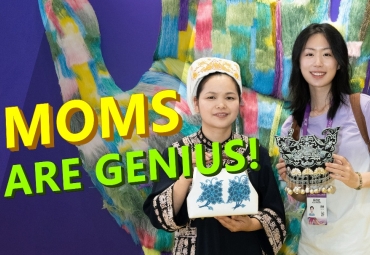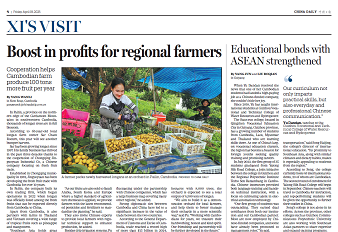Colorful ethnic art exhibition delights Shanghai

A painter from Pingpo village in Longli county, Guizhou province, introduces her work to visitors at an exhibition held in Qianxinan prefecture, Guizhou, in July. LONG YI/FOR CHINA DAILY
The Shanghai Museum of Glass is currently hosting an exhibition of Pingpo Miao paintings, which has been received with great fanfare by art aficionados.
The unique paintings are all created by a group of female villagers from mountainous areas of Guizhou province in southwestern China.
The paintings originated from the province's Pingpo village, Longli county, which is a major settlement of the Xiaohua Miao, a branch of the Miao ethnic group.
"These paintings amazed me when I first saw them. They are truly vibrant," said Lei Jia, curator of the exhibition.
The exhibition, which offers glimpses into the Miao ethnic culture, kicked off on Feb 7 and has attracted more than 10,000 visitors.
Pingpo Miao paintings are mainly done by female artists ages 20 to 80, who unleash their creativity after a day of farm work and domestic chores.
They learn the art form from elderly villagers, absorbing it through personal examples and verbal instructions.
However, many of the female painters can hardly afford the painting materials, said Lei. The number of female painters has also dwindled to around 20 as they have less leisure time to paint, he said.
Inspired by traditional customs and beliefs, Pingpo Miao paintings are full of beautiful and creative images. They depict changes in the daily lives of the Xiaohua Miao people in an authentic and vivid manner.
The female artists use abstract patterns to illustrate water and fish and the never-ending cycle of life.
To help more people understand the Miao ethnic art, the Shanghai Museum of Glass has created a modern neon installation as part of the exhibition. The installation, named Butterfly, uses colorful neon pipes to reconstruct the symbol of the Miao people's ethnic origin.
Zhang Lin, director of the Shanghai Museum of Glass, said, "Visitors love these artworks created by passionate artists living in the mountainous regions of China as their works embody the originality of Chinese folk art."
The exhibition has also opened a window for visitors to experience their world, paving the way for a dialogue between the Miao culture and urban lifestyle, Zhang said.
All rights Reserved. 京ICP备13028878号-8







 Overview
Overview Guiyang
Guiyang Guian New Area
Guian New Area Liupanshui
Liupanshui Anshun
Anshun Qianxinan
Qianxinan Qiandongnan
Qiandongnan Qiannan
Qiannan Zunyi
Zunyi Tongren
Tongren Bijie
Bijie Guizhou commits to culture preservation and rural vitalization
Guizhou commits to culture preservation and rural vitalization Guizhou voice at 2025 national two sessions
Guizhou voice at 2025 national two sessions Meet the 'genius moms' at Shenzhen cultural fair
Meet the 'genius moms' at Shenzhen cultural fair 

